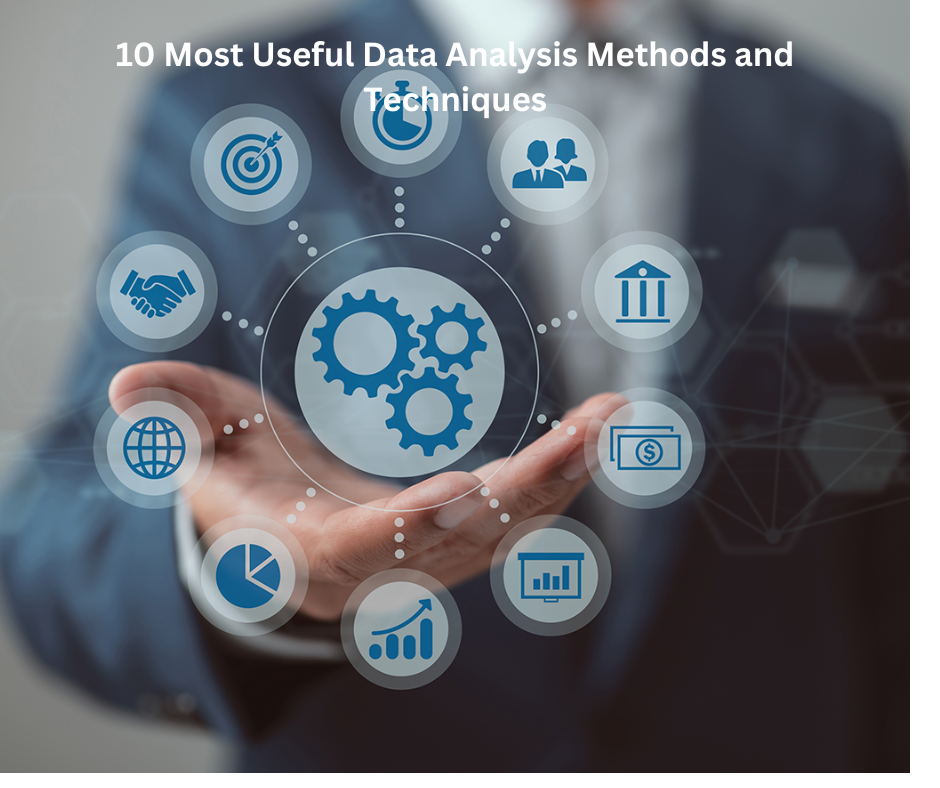10 Most Useful Data Analysis Methods and Techniques in 2024
 Ruhi Parveen
Ruhi Parveen
Data analysis is a crucial aspect of modern business and research, helping organizations make informed decisions and uncover valuable insights from data. In 2024, with the ever-increasing volume and complexity of data, it's more important than ever to use effective methods and techniques for data analysis. Here are ten of the most useful methods and techniques:
1. Descriptive Statistics
Descriptive statistics involve summarizing and organizing data to make it understandable and interpretable. Key measures include:
Measures of central tendency: Mean, median, mode.
Measures of dispersion: Range, variance, standard deviation.
Visualization tools: Histograms, box plots, and scatter plots.
Descriptive statistics provide a snapshot of the data's main characteristics, helping analysts understand the data's distribution and key features.
2. Inferential Statistics
Inferential statistics help in making predictions and decisions about a population based on a sample of data. Key techniques include:
Hypothesis testing: Assessing if results from a sample are likely to occur in the population.
Confidence intervals: Estimating the range within which population parameters lie.
Regression analysis: Examining relationships between variables.
Inferential statistics are crucial for drawing conclusions beyond the immediate data sample, making them vital in research and decision-making.
3. Data Mining
Techniques include:
Association rule mining: Identifying relationships between variables in transactional data.
Clustering analysis: Grouping similar data points together.
Classification analysis: Predicting categorical variables based on other features.
Data mining is instrumental in uncovering hidden patterns that can inform business strategies and improve decision-making processes.
4. Machine Learning
Machine learning uses algorithms to learn from data and make predictions or decisions. Types of machine learning techniques include:
Supervised learning: Predicting outcomes using labeled data (e.g., regression, classification).
Unsupervised learning: Finding patterns in data without predefined outcomes (e.g., clustering).
Deep learning: Using neural networks to analyze large amounts of data.
Machine learning is increasingly used in diverse fields such as finance, healthcare, and marketing to automate processes and gain predictive insights.
5. Text Analytics
Text analytics involves analyzing unstructured text data to derive meaningful insights. Techniques include:
Sentiment analysis: Determining the sentiment expressed in text data.
Topic modeling: Identifying topics or themes within a collection of documents.
Text classification: Categorizing documents based on content.
Text analytics is vital for understanding customer feedback, social media trends, and analyzing large volumes of textual data.
6. Time Series Analysis
Time series analysis deals with data points indexed in chronological order. Techniques include:
Seasonal decomposition: Separating data into seasonal and trend components.
Forecasting: Predicting future values based on historical data.
Time series analysis is essential in finance, economics, and environmental sciences for predicting future trends and making informed decisions.
7. Spatial Analysis
Techniques include:
Spatial clustering: Identifying clusters of similar geographic entities.
Spatial interpolation: Estimating values at unsampled locations based on nearby measurements.
Network analysis: Analyzing connections and flows within a geographic network.
Spatial analysis is crucial in urban planning, environmental studies, and logistics for optimizing resource allocation and understanding spatial relationships.
8. Bayesian Methods
Bayesian methods use Bayes' theorem to update the probability for a hypothesis as more evidence or information becomes available. Techniques include:
Bayesian inference: Updating beliefs about parameters based on observed data.
Bayesian networks: Modeling probabilistic relationships between variables.
Markov Chain Monte Carlo (MCMC): Sampling from complex probability distributions.
Bayesian methods are valuable for decision-making under uncertainty and are widely used in fields like healthcare, engineering, and finance.
9. Data Visualization
Data visualization uses graphical representations to communicate insights from data effectively. Techniques include:
Charts and graphs: Bar charts, line graphs, pie charts.
Heatmaps and matrices: Representing data density and relationships.
Interactive dashboards: Allowing users to explore data dynamically.
Data visualization enhances data-driven storytelling and aids in understanding complex relationships within data sets.
10. Prescriptive Analytics
Prescriptive analytics goes beyond descriptive and predictive analytics to recommend actions based on data analysis. Techniques include:
Optimization models: Finding the best solution given constraints.
Simulation: Modeling scenarios to predict outcomes under different conditions.
Decision analysis: Evaluating decision options based on their outcomes.
Prescriptive analytics helps organizations make data-driven decisions to optimize processes and achieve strategic goals.
Conclusion
In conclusion, data analysis methods and techniques are essential for extracting valuable insights from data in modern business and research. In 2024, with the increasing volume and complexity of data, these methods are more crucial than ever. From descriptive and inferential statistics to advanced techniques like machine learning and prescriptive analytics, organizations have a wide array of tools to analyze data effectively. By leveraging these methods, businesses can make informed decisions, optimize processes, and gain a competitive edge in today's data-driven world. For those looking to enhance their data analytics skills, there are reputable Data Analytics Training Institute in Bhopal, Delhi, Noida, Mumbai, Indore, and other parts of India, offering comprehensive courses to meet the growing demand for data professionals.
Subscribe to my newsletter
Read articles from Ruhi Parveen directly inside your inbox. Subscribe to the newsletter, and don't miss out.
Written by

Ruhi Parveen
Ruhi Parveen
I am a Digital Marketer and Content Marketing Specialist, I enjoy technical and non-technical writing. I enjoy learning something new.